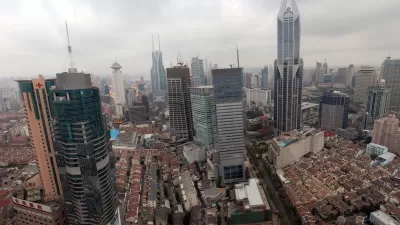China has added to the ranks of the world's megacities at a ridiculous clip. Even so, inland cities have tended to languish in anonymity. With new policies and economic orientations, the Chonquings are starting to compete with the Shanghais.

With an export-oriented economy, it's no wonder that China's major cities have traditionally been on the coast, most notably Shanghai and the cluster around the Pearl River Delta. Tens of millions of migrants have left rural interior areas to seek fortune in these cities.
With the rise of new technologies and new economic sectors, access to shipping routes and the perceived cosmopolitanism of the coasts is becoming less crucial. Cities such as Chongqing are benefiting from a combination of government programs, like high-speed rail and new borrowing opportunities, and economic advances, like expertise in manufacturing laptops, have given it one of the highest rates of urban GDP growth in China. Meanwhile, even Beijing has outperformed, with robust economic activity above and beyond the government activity that takes place in the capital.
"Coastal cities like Shanghai, Mumbai and New York have traditionally been centers not only of trade but also of commerce, culture, and wealth. They monopolize infrastructure investment and media attention, and occupy the longings of aspirational youth seeking stimulation and opportunity. With this inherent advantage, however, come the practical challenges of overpopulation: infrastructure deficits, soaring property values, and glaring inequalities in wealth distribution that some argue compromise the social fabric. Furthermore, coastal cities are increasingly vulnerable to sea level rise associated with climate change."
"With increased autonomy, improved infrastructure, and an outward orientation, China’s inland cities have fiercely global ambitions that may help them outpace urban growth in the West. These cities view even their coastal counterparts – larger Chinese mega-regions – as competitors for investment and labor. Indeed, government data indicate that many migrants are returning from coastal cities to their home provinces, drawn by employment opportunities. Moreover, the recent announcement by China’s State Council that it would develop urban clusters along the Yangtze River raises additional prospects for inland growth. Ambition is now meeting preparedness"
FULL STORY: The Rise of China’s Inland Cities

Maui's Vacation Rental Debate Turns Ugly
Verbal attacks, misinformation campaigns and fistfights plague a high-stakes debate to convert thousands of vacation rentals into long-term housing.

Planetizen Federal Action Tracker
A weekly monitor of how Trump’s orders and actions are impacting planners and planning in America.

In Urban Planning, AI Prompting Could be the New Design Thinking
Creativity has long been key to great urban design. What if we see AI as our new creative partner?

Cal Fire Chatbot Fails to Answer Basic Questions
An AI chatbot designed to provide information about wildfires can’t answer questions about evacuation orders, among other problems.

What Happens if Trump Kills Section 8?
The Trump admin aims to slash federal rental aid by nearly half and shift distribution to states. Experts warn this could spike homelessness and destabilize communities nationwide.

Sean Duffy Targets Rainbow Crosswalks in Road Safety Efforts
Despite evidence that colorful crosswalks actually improve intersection safety — and the lack of almost any crosswalks at all on the nation’s most dangerous arterial roads — U.S. Transportation Secretary Duffy is calling on states to remove them.
Urban Design for Planners 1: Software Tools
This six-course series explores essential urban design concepts using open source software and equips planners with the tools they need to participate fully in the urban design process.
Planning for Universal Design
Learn the tools for implementing Universal Design in planning regulations.
Appalachian Highlands Housing Partners
Gallatin County Department of Planning & Community Development
Heyer Gruel & Associates PA
Mpact (founded as Rail~Volution)
City of Camden Redevelopment Agency
City of Astoria
City of Portland
City of Laramie





























